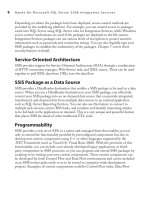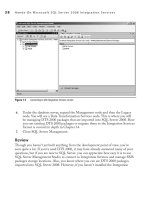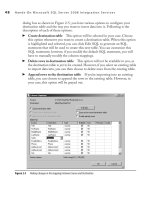Hands-On Microsoft SQL Server 2008 Integration Services part 6 potx
Bạn đang xem bản rút gọn của tài liệu. Xem và tải ngay bản đầy đủ của tài liệu tại đây (269.25 KB, 10 trang )
28 Hands-On Microsoft SQL Server 2008 Integration Services
log information are moved to Integration Services 2008 format and existing tables are
removed after the upgrade. There are more things for you to do while upgrading that
are discussed in detail in Chapter 14.
Upgrading Data Transformation Services to Integration Services 2008 is not that
straightforward, though SQL Server 2008 provides tools to upgrade. This is due to
major differences in the architecture of DTS 2000 and Integration Services. Chapter 14
discusses all the options that you have for upgrading your existing DTS 2000 packages
to Integration Services.
Business Intelligence Development Studio
Business Intelligence Development Studio is designed for developing business intelligence
solutions, including Integration Services packages, Reporting Services reports, and
Analysis Services cubes and OLAP databases. BIDS is built on Visual Studio 2008,
which allows you to design, build, test, execute, deploy, and extend Integration Services
packages in an integrated development environment. Because of Visual Studio 2008
integration, BIDS provides the advantage of having integrated development features, a
debugger, integrated help, and an integrated source control (such as Visual Studio Team
Foundation Server or Visual SourceSafe) environment. You can use the same techniques
to develop and store Analysis Services, Reporting Services, and Integration Services
projects with BIDS. You can also develop a solution using BIDS that can have multiple
Integration Services, Analysis Services, and Reporting Services projects.
BIDS is based on usual application design philosophy of solutions and projects. This
provides lots of benefits, including the following:
You don’t need to have an SQL Server to develop an Integration Services package
c
as was the case with DTS 2000, which required SQL Server 2000 Enterprise
Manager to design and develop a package. Integration Services development and
execution environments are fairly independent from the SQL Server Engine;
however, the presence of SQL Server on the same server where the Integration
Services service is running offers additional benefits such as ability to store
packages in an MSDB database and to schedule running of SSIS packages using
the SQL Server Agent.
Your development gets an organized structure so that a number of projects can be
c
run under the context of one solution and these projects further can be of different
types such as Integration Services, Reporting Services, Analysis Services, or a C#
class library project. Integration Services projects can contain data sources, data
source views, SSIS packages, and other miscellaneous files. Availability of all of the
support DDL and DML files at one place makes deployment a very easy task.
Chapter 1: Introducing SQL Server Integration Services 29
Direct integration with Source Control servers such as the Visual Studio Team c
Foundation Server or Visual SourceSafe or one of many third-party source control
servers facilitates immediate check-in whenever changes are made to projects. is
feature enables a team to work on different parts of a project at the same time. BIDS
doesn’t work directly on packages stored in SQL Server, so during development, you
should be saving your packages in the file system and checking in whenever making
changes or on daily basis or on completion of a development cycle. For packages
stored in SQL Server, BIDS imports them first by creating a copy on the file system
and only then allows you to make changes to your code. After making changes, you
will need to save those packages back into SQL Server. Hence, it is easier and better
to work with the file system in development environment.
Being built on the .NET Framework, BIDS makes it very easy to develop Custom
c
Tasks or Components using .NET languages such as C# or Visual Basic 2008. As
mentioned earlier, these custom development projects can also reside under the
same solution.
The BIDS environment consists of various windows. Among the main windows
are SSIS Designer, Solution Explorer, Toolbox, Variables, and Properties, in addition
to other windows, such as Output, Error List, and Task List. All these windows can be
docked anywhere and can be tabbed on to the main Designer window, set to autohide, or
closed. These features provide a fantastic UI configuration feature that allows developers
to customize their environment (to free up working space) and boost productivity.
Let’s take a closer look at BIDS. In the following Hands-On exercise, you will create
a blank Integration Services project and will learn various aspects of this tool.
Hands-On: Creating a Blank Integration Services Project
The objective of this exercise is to create your first blank Integration Services project
and study various aspects of BIDS while working with it. You will use this project in
Chapter 2 to add packages to it and take it further.
Exercise (Creating a Blank Integration Services Project)
In this part, you will learn about the Integration Services development environment
within the Business Intelligence Development Studio while creating a blank project.
1. Choose Start | All Programs | Microsoft SQL Server 2008 and then click SQL
Server Business Intelligence Development Studio to open this tool.
2. When the BIDS screen appears, choose File | New and then click Project.
Alternatively, you can create a new project by clicking the Project URL next to
the Create in Recent Projects section on the Start page. This will open the New
30 Hands-On Microsoft SQL Server 2008 Integration Services
Project dialog box, in which the Business Intelligence Projects option is selected
by default in Project Types. In the Templates pane, select Integration Services
Project and then fill in the following details in the fields provided in the lower
section of the dialog box (see Figure 1-3).
Name My First SSIS Project
Location C:\SSIS\Projects
Do not select the check box for Create Directory For Solution, as we do not want
a parent folder for a solution to be created in this instance. Click OK when you
have filled in these details to create an Integration Services Project.
3. The BIDS will create a blank Integration Services Project and will show you
blank designer surface and the Package.dtsx SSIS package created in the Solution
Explorer window as shown in Figure 1-4.
Let’s take this opportunity to learn a bit more about the windows that make up an
Integration Services project in the BI Development Studio.
Figure 1-3 Templates for creating new projects in BIDS
Chapter 1: Introducing SQL Server Integration Services 31
SSIS Designer
Notice the central area in the BIDS that has four tabs: Control Flow, Data Flow,
and Event Handlers along with the design surfaces, and one Package Explorer tab to
show components used in the package in a hierarchical structure; it is called the SSIS
Designer. These are the design surfaces for developing Integration Services packages,
while BIDS provides different designer surfaces for other BI project types such as
Reporting Services and Analysis Services projects. The SSIS Designer provides a
graphical view of objects that make data movement, workflow, and Integration Services
development work possible with minimal or no programming at all.
At the top of the designer, the name of the package, Package.dtsx, is shown. It has
three design surfaces—Control Flow, Data Flow, and Event Handlers—along with
one Package Explorer tab to show components used in the package in a hierarchical
structure. You can have multiple packages open at one time, each with its own design
surfaces displayed in a tabular form. The layout of SSIS Designer displaying design
surfaces in tab groups makes it particularly useful for handling large projects with many
Figure 1-4 Your first blank Integration Services project
32 Hands-On Microsoft SQL Server 2008 Integration Services
packages open at the same time. There are other windows in the BIDS such as Solution
Explorer, Toolbox, Properties, Error List, and Output. Not all the windows display at
all times.
The workspace in BI Development Studio can be completely managed by the user
as all the windows other than SSIS Designer can be docked anywhere in the working
area, can float, can be tabbed in the SSIS Designer, can be set to autohide, or can
be completely hidden or closed. If you click the down arrow button displayed in the
Solution Explorer’s menu bar, you will see these options. The other two buttons—a
pushpin and a cross—are used to set windows to autohide or hide (close) respectively.
By default, the Toolbox window is in autohide mode, hanging on the left side of the
SSIS Designer, and the Solution Explorer is docked on the right side of the SSIS
Designer. This is also shown in the Figure 1-4.
Solution Explorer
The Solution Explorer window provides an organized view of projects and files
associated with them. The active solution lies at the top of the logical container and
contains one or more different types of projects below it. You can add various other
projects to a solution such as analysis services projects or reporting services projects to
organize your different units of work all in one place.
Because the different projects store files in different ways, the Solution Explorer
window does not reflect the physical storage of files. After you create an Integration
Services project, you can attach it to a solution later on. You can attach a project or a
file to a solution, but a project allows you to attach only files. You add files or projects
by right-clicking the solution or the project in the Solution Explorer window and
choosing Add from the context menu.
Properties Window
The Properties window is located at the lower right of the BIDS interface (see Figure 1-4).
This is also a context-sensitive window and shows the properties of the item or object you
have selected. Having the Properties window open during design time is a great time-
saver. Like other windows, you can close the window or move it around on the desktop.
You can open this window again from the View menu or by pressing
4.
Toolbox
You probably noticed a tabbed window on the left side of the SSIS Designer (see
Figure 1-4) called the Toolbox. The Toolbox contains preconfigured tasks provided
by Integration Services in the Control Flow tab, and the Data Flow tab has Data
Chapter 1: Introducing SQL Server Integration Services 33
Flow Sources, Data Flow Transformations, and Data Flow Destinations. The tasks
are organized in two sections in the Toolbox window, which shows the tasks that are
relevant to the project type you are working with. When you are in the Control Flow
tab of the Designer window and open the Toolbox, you will see Control Flow Items;
if you’re in the Data Flow tab of the Designer, you will see Data Flow Sources, Data
Flow Transformations, and Data Flow Destinations sections.
Control Flow Tab
The Control Flow tab consists of the tasks, arranged in the order in which they are
performed—that is, precedence constraints and the looping structure defined by
looping structure containers For Loop, Foreach Loop, and Sequence. You can draw
objects on the graphical surface of the Designer and link them with other objects by
dragging and dropping an arrow that extends from one object to another. This arrow
signifies a precedence constraint and can be of type OnSuccess, which appears in
green; OnCompletion, which appears in blue; and OnFailure, which appears in red. By
defining the tasks and the precedence constraints between them, you design the control
flow of your package and thus define the workflow in your package. You can logically
group tasks to simplify complex packages and annotate them with text boxes to provide
an explanation of the task. You will study more about precedence constraints and other
control flow components in Chapters 3 to 5.
Data Flow Tab
The Data Flow Designer consists of the source adapters that extract data from
heterogeneous data sources; the transformations that modify, aggregate, or extend data;
and the destination adapters that load the transformed data into the final data stores.
A package must include at least one Data Flow task in order to implement a data flow.
You can create multiple Data Flow tasks in a package and create multiple data flows
within a Data Flow task. The data is extracted from a source using source adapters
and loaded to the destination using destination adapters. In between source adapters
and destinations adapters you use transformations to modify, aggregate, and extend
column data and to apply business logic to convert data. The flow of data from source
to destination with transformations along the way is linked together with green or red
lines called data flow paths. Adding data viewers to a path enables you to see the data as
it moves from source to destination. This helps you debug and locate a troublemaking
component that is converting data incorrectly. Extensive error handling can be included
in the data flow task; for instance, error rows can be routed to a different destination
whenever there is a row-level fault, to capture, analyze, and maybe correct and feed
back to the main data flow.
34 Hands-On Microsoft SQL Server 2008 Integration Services
Event Handlers Tab
You can extend package functionality by using event handlers, which are helpful in
managing packages at run time. Event handlers are like subpackages waiting for the
events to be raised so that they can come to life. They are powerful tools that can
extend the package functionality greatly when properly implemented. Event handlers
are created for the packages, Foreach Loop container, For Loop container, and
Sequence container, as well as for the tasks in the same way as you create packages.
Once created, event handlers can be explored in the Package Explorer tab by first
expanding the Package and then expanding the Executables and finally expanding the
Event Handlers node.
Package Explorer Tab
The Package Explorer represents the container hierarchy of the SSIS object model
and lists all the package objects. This is the interface through which you can execute
a package and monitor the running package. When you click the Package Explorer
tab, your package appears at the top of the hierarchy. Click the Package to expand
and expose the Variables, Executables, Precedence Constraints, Event Handlers,
Connection Managers, and Log Providers objects. Event handlers are members of
the Event Handlers collection, and all executables include this collection. When you
create an event handler, SSIS adds the event handler to the Event Handlers collection.
The Package Explorer tab in SSIS Designer lists the event handlers for an executable.
Expand the Event Handlers node to view the event handlers that executable uses.
Progress Tab or Execution Result Tab
This tab doesn’t show up during design time when you are still developing the package.
When you run an Integration Services package in BIDS, a Progress tab will appear
within the SSIS Designer. This Progress tab converts to an Execution Result tab once
the package execution is completed and you’ve switched back to the design mode.
Integration Services writes extensive information in this tab while executing a package.
All sorts of information such as validation of tasks, start time, finish time, warnings,
errors, failure messages, suggestions, and execution details, including the number of
rows affected, are all written here. Once you become more familiar with Integration
Services, you may find that this tab contains a bit more information than what you
would like to see. For these reasons, you may find that Output window contains more
concise and relevant information. However, if you are new to Integration Services, this
tab provides some interesting information, such as the optimization hints in case more
columns have been extracted than used in the data flow, and you may find these kinds
of messages a learning aid to design better and more efficient packages.
Chapter 1: Introducing SQL Server Integration Services 35
Connection Managers Area
In this area, you add various connection managers, depending on the requirements of
your package. For example, if your package needs to connect to a flat file, you will add
a Flat File connection manager; if your package needs to connect to an SQL Server
database, you will add an OLE DB connection manager.
BIDS provides many other windows for additional informational purposes. Some of
these are described next, while others will be introduced wherever used.
Code Window
You can see the code of a package or an object in the SSIS Designer. To see this, go to
the Solution Explorer window, right-click Package.dtsx, and choose View Code from
the context menu. An additional tab on the SSIS Designer surface appears with a listing
of code in XML form.
Task List Window
In the Task List window, you can add notes for descriptive purposes or as a follow-
up for later development; you can also organize and manage the building of your
application. To open the task list, choose View | Task List. These tasks can be filtered
and sorted based on the predefined options provided.
Output Window
The Output window displays informational messages, including errors that occur during
building, deployment, or run time. Third-party external tools can list their output to the
Output window as well. Press the green triangle (play) button on the Standard toolbar
to debug the package. The package completes execution immediately, as there is no task
within the package, and you can see Output window open at the bottom of the screen
among other windows. If you don’t see it there, go to View menu and click Output from
the option list to open it. Note that the Output window shows package start, finish, and
success messages. The Output window has multiple panes to show information specific
to the process that is sending informational messages. These panes can be accessed from
the Show Output From drop-down box in the Output window. Click the down arrow
and select Build to display messages from the build process.
Error List Window
This window provides detailed description of validation errors during design time. It
also shows errors, warnings, and messages for the package you are developing. To open
this window, choose View | Error List.
36 Hands-On Microsoft SQL Server 2008 Integration Services
Locals Window
This window displays information about the local expressions and is available only when
the package is in debug mode. When you use a breakpoint to stop package execution to
debug, you can come to the Locals window and see values of variables at that particular
moment. This is very useful and effective when you’re debugging your package.
Watch Window
Like the Locals window, the Watch window is also available during debug mode and
displays information only about the expressions that you’ve selected. For example, you
can watch a variable to see how its value changes as the package execution progresses.
You can open up to four watch windows.
1. Stop debugging of the package by pressing -5.
2. Using Windows Explorer, go to the C:\SSIS\Projects folder and note that various
files have been created under the My First SSIS Project folder. Note the extension
and type of these files, as each one of them represents a different function in the
Integration Services project.
e *.sln file is the main file for a solution or project and contains solution
c
configuration settings and the list of projects the solution contains.
e *.dtproj files are similar files, but contain information for project
c
configurations and the items such as packages they contain.
e *.database file contains information required for internal use by BIDS.
c
e .dtsx files are the code files for your packages. ese files are independent c
and self-contained and are not hard-bound with the solution in which they are
created. is means that they can be freely copied between projects and folders.
e file *.suo, called Visual Studio Solution User Options, and the file
c
*.dtproj.user, called Visual Studio Project User Options, are the two user
settings files used by Integration Services at the solution and project levels.
e bin folder keeps the backups of the previous build versions of packages.
c
Congratulations! You have completed your first Integration Services project Hands-On.
Review
You’ve had your first encounter with the BIDS and created a blank Integration Services
Project. Although you haven’t developed much in the package, you have understood
enough about the environment and the package itself that you’re almost ready to get
creative and develop a working package.
Chapter 1: Introducing SQL Server Integration Services 37
SQL Server Management Studio
SQL Server Management Studio is the main tool used to manage SQL Server databases
and run T-SQL queries against the tables and the views. This tool also enables you to
connect to the Integration Services service and perform management operations such
as run packages, monitor running packages, manage package storage on the file system
as well as the MSDB database, import and export packages from one storage area to
another, assign Package Roles to control access, and upgrade packages. Let’s start using
this tool straightaway with a very simple Hands-On.
Hands-On: Connecting to Integration Services Service
In this exercise, you will connect to Integration Services and will also explore where
DTS 2000 packages can be managed within SQL Server Management Studio.
Exercise (Using SQL Server Management Studio)
You have used BIDS earlier to create a blank project. While BIDS provides a development
environment for developing SSIS packages, SQL Server Management Studio enables you
to manage the deployed packages. In this part, you will connect to Integration Services
using SQL Server Management Studio.
1. From Start | All Programs | Microsoft SQL Server 2008 and then click SQL
Server Management Studio.
2. When the SQL Server Management Studio loads, you will see the Connect
To Server dialog box, where you can choose a server type to which you want to
connect and provide your authentication details. Click in the Server Type field
and select Integration Services from the drop-down list. Type localhost in the
Server Name field to connect to the local server and press Connect.
3. SQL Server Management Studio will connect to Integration Services and show
you Running Packages and Stored Packages folders under Integration Services in
the Object Explorer, as shown in Figure 1-5.
4. Expand these folders. You will not see any packages listed under Running Packages
because no packages have yet been created. Click the Stored Packages folder and
you’ll see the File System and MSDB folders. This is where you will be managing
the packages you’ve stored in the file system or the MSDB database in SQL
Server. Managing these folders and the packages is covered in detail in Chapter 6.
5. Let’s do a little more research to see where DTS 2000 packages go. In the Object
Explorer window, click Connect and choose Database Engine from the drop-down
list. Note that you can connect to Integration Services from here as well. Leave
localhost as the Server Name and verify that Windows Authentication is selected
in the Authentication field. Click Connect to connect to the local database server.









